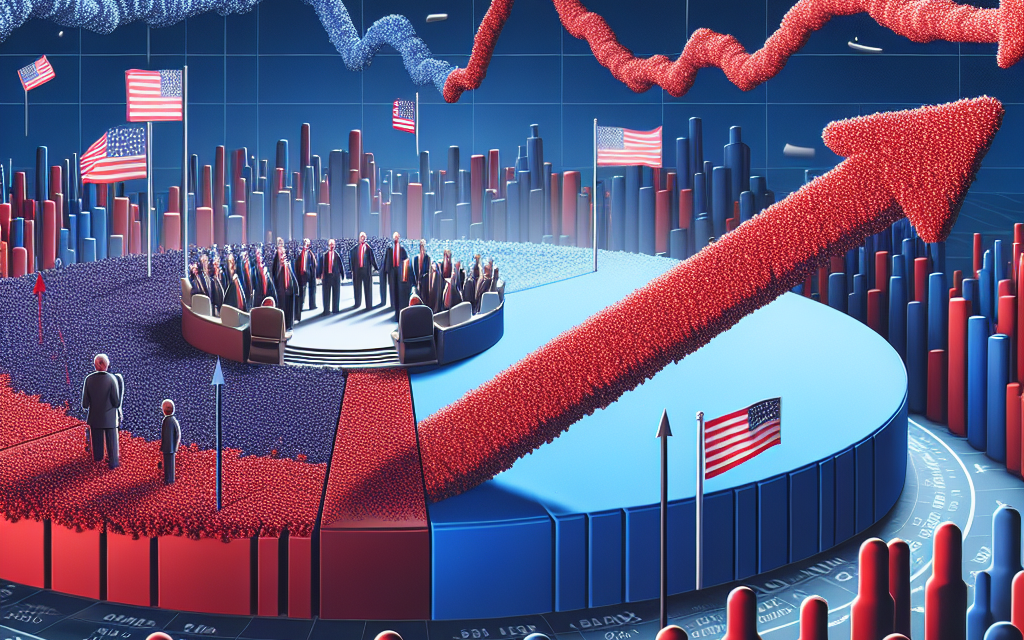“Confidence Surges: Credit Market Risk Plummets with Trump’s Imminent Triumph”
Introduction
As the 2016 U.S. presidential election approached its climax, financial markets were on high alert, closely monitoring the potential implications of a Donald Trump victory. In a surprising turn of events, the credit market, often a barometer of economic sentiment and stability, experienced a significant decline in perceived risk as Trump neared victory. This shift was marked by a decrease in credit default swap spreads and a rally in corporate bonds, signaling increased investor confidence in the creditworthiness of borrowers. The market’s reaction was driven by expectations of Trump’s pro-business policies, including tax cuts, deregulation, and infrastructure spending, which were anticipated to stimulate economic growth and enhance corporate profitability. As investors recalibrated their risk assessments, the credit market’s response underscored the complex interplay between political developments and financial market dynamics.
Impact Of Political Events On Credit Market Risk
As the political landscape shifts with Donald Trump nearing a potential victory, the credit market is experiencing a notable decline in risk. This phenomenon underscores the intricate relationship between political events and financial markets, where investor sentiment and market stability are often influenced by the prevailing political climate. The anticipation of Trump’s victory has led to a recalibration of risk assessments within the credit market, reflecting a broader trend of how political developments can impact financial instruments and investor behavior.
To understand this dynamic, it is essential to consider the mechanisms through which political events influence credit market risk. Political stability often serves as a cornerstone for economic confidence, and the prospect of a Trump victory is perceived by some investors as a continuation of policies that favor economic growth and deregulation. This perception can lead to increased investor confidence, thereby reducing the perceived risk associated with credit markets. As investors anticipate a stable political environment, they are more likely to engage in lending and investment activities, which in turn lowers the risk premiums demanded by creditors.
Moreover, the potential for policy continuity under a Trump administration may also contribute to this decline in credit market risk. Trump’s economic policies, characterized by tax cuts and deregulation, have historically been viewed as conducive to business growth and investment. As such, the expectation of similar policies being implemented or maintained can lead to a more favorable economic outlook, further reducing credit market risk. Investors, anticipating a business-friendly environment, may adjust their risk assessments accordingly, leading to a more stable credit market.
In addition to policy expectations, the psychological impact of political events on investor behavior cannot be underestimated. The prospect of a Trump victory may evoke a sense of familiarity and predictability among investors who have previously navigated the economic landscape under his administration. This familiarity can translate into reduced uncertainty, as investors feel more equipped to anticipate and respond to potential policy changes. Consequently, this reduction in uncertainty can lead to a decline in credit market risk, as investors are more willing to engage in lending and investment activities with greater confidence.
However, it is important to recognize that the relationship between political events and credit market risk is not always straightforward. While some investors may view a Trump victory as a positive development, others may harbor concerns about potential geopolitical tensions or domestic policy shifts that could introduce new risks. Therefore, the overall impact on credit market risk is contingent upon a multitude of factors, including investor perceptions, policy expectations, and broader economic conditions.
In conclusion, the decline in credit market risk as Trump nears victory highlights the significant impact that political events can have on financial markets. By influencing investor sentiment and shaping economic expectations, political developments play a crucial role in determining the stability and risk profile of credit markets. As investors navigate this evolving landscape, it is essential to remain attuned to the complex interplay between politics and finance, recognizing that shifts in political power can have far-reaching implications for market dynamics. Through careful analysis and strategic decision-making, investors can better position themselves to manage risk and capitalize on opportunities in an ever-changing political and economic environment.
Analyzing The Correlation Between Elections And Financial Markets
As the United States approaches another pivotal election, the financial markets are closely monitoring the potential outcomes and their implications. Historically, elections have had a profound impact on market dynamics, with investors often reacting to the anticipated policies of the candidates. In the current scenario, as Donald Trump edges closer to a potential victory, a notable trend has emerged: a significant decline in credit market risk. This development warrants a closer examination of the correlation between electoral outcomes and financial market behavior.
To begin with, it is essential to understand the nature of credit market risk. This risk pertains to the possibility that borrowers may default on their obligations, thereby affecting lenders and investors. Credit market risk is influenced by a myriad of factors, including economic conditions, interest rates, and political stability. Elections, particularly in major economies like the United States, can introduce a degree of uncertainty that impacts these factors, thereby influencing credit market risk.
In the context of the current election cycle, the prospect of a Trump victory appears to have alleviated some of the concerns that typically accompany electoral uncertainty. This can be attributed to several reasons. Firstly, Trump’s previous tenure as President provides a reference point for investors, who may feel more confident in predicting the potential economic policies and their implications. His administration was characterized by tax cuts, deregulation, and a focus on economic growth, which were generally well-received by the markets. Consequently, the anticipation of similar policies may be contributing to the reduction in perceived credit market risk.
Moreover, Trump’s approach to international trade and relations could also be playing a role in this trend. During his presidency, Trump adopted a more protectionist stance, renegotiating trade deals and imposing tariffs to protect American industries. While this approach was controversial, it did lead to a degree of predictability in trade relations, which can be reassuring for investors concerned about global economic stability. As such, the possibility of a return to these policies may be seen as a stabilizing factor, further reducing credit market risk.
Additionally, it is important to consider the broader economic context in which this election is taking place. The global economy is gradually recovering from the disruptions caused by the COVID-19 pandemic, and there is a general sense of optimism about future growth prospects. In this environment, the potential for a Trump victory may be perceived as a continuation of pro-business policies that could support economic recovery, thereby reducing the likelihood of defaults and enhancing credit market stability.
However, it is crucial to acknowledge that the relationship between elections and financial markets is complex and multifaceted. While the prospect of a Trump victory may be contributing to a decline in credit market risk, other factors, such as monetary policy and global economic conditions, also play a significant role. Furthermore, the outcome of the election is not yet certain, and any shifts in the political landscape could lead to changes in market perceptions.
In conclusion, as Donald Trump nears a potential victory, the observed decline in credit market risk highlights the intricate interplay between electoral outcomes and financial market behavior. While the anticipation of familiar economic policies may be providing a sense of stability, it is essential for investors to remain vigilant and consider the broader economic and political context. As the election unfolds, the financial markets will continue to adapt, reflecting the evolving landscape and its implications for credit market risk.
Credit Market Trends During Political Transitions
As the political landscape shifts with Donald Trump nearing a potential victory, the credit market is experiencing a notable decline in risk. This development is particularly significant given the historical volatility often associated with political transitions. Investors and financial analysts are closely monitoring these changes, as the credit market serves as a barometer for economic stability and investor confidence. The decline in credit market risk can be attributed to several factors, each interwoven with the broader political and economic context.
Firstly, the anticipation of Trump’s victory has led to increased market optimism, primarily driven by his proposed economic policies. These policies, which emphasize tax cuts, deregulation, and infrastructure spending, are perceived as pro-business and growth-oriented. Consequently, investors are more confident in the economic outlook, leading to a reduction in perceived credit risk. This optimism is reflected in the narrowing of credit spreads, which indicate a lower premium for riskier debt. As credit spreads tighten, it signals that investors are more willing to take on risk, expecting stable or improving economic conditions.
Moreover, the potential continuity of Trump’s administration suggests a degree of policy predictability, which further reduces uncertainty in the credit markets. Political transitions often bring about concerns regarding abrupt policy changes that could disrupt economic stability. However, with Trump nearing victory, the expectation of continued policies provides a sense of stability. This continuity is particularly reassuring for sectors that have benefited from his administration’s previous policies, such as energy, finance, and manufacturing. As these sectors anticipate favorable conditions, their creditworthiness improves, contributing to the overall decline in market risk.
In addition to policy predictability, the global economic environment plays a crucial role in shaping credit market trends. The current global economic recovery, albeit uneven, supports a more favorable credit market environment. As major economies rebound from the pandemic-induced downturn, there is a resurgence in trade and investment activities. This global recovery bolsters corporate earnings and strengthens balance sheets, thereby enhancing credit profiles. Consequently, the improved financial health of corporations reduces the likelihood of defaults, further diminishing credit market risk.
Furthermore, central banks’ accommodative monetary policies continue to underpin credit market stability. Low interest rates and quantitative easing measures have provided ample liquidity, encouraging borrowing and investment. This monetary support has been instrumental in sustaining economic growth and mitigating financial stress. As a result, the credit market benefits from a supportive backdrop, with lower borrowing costs and increased access to capital. This environment fosters confidence among investors, contributing to the observed decline in credit market risk.
While the reduction in credit market risk is a positive development, it is essential to remain vigilant of potential challenges. Geopolitical tensions, inflationary pressures, and unforeseen economic shocks could disrupt the current trajectory. Therefore, continuous monitoring and prudent risk management are imperative to navigate the evolving landscape.
In conclusion, as Donald Trump nears victory, the credit market is witnessing a significant decline in risk, driven by market optimism, policy predictability, global economic recovery, and supportive monetary policies. These factors collectively contribute to a more stable credit environment, reflecting increased investor confidence. However, it is crucial to remain attentive to potential risks that could alter this favorable trend. As the political transition unfolds, the credit market will continue to serve as a critical indicator of economic resilience and stability.
The Role Of Investor Sentiment In Credit Market Fluctuations
As Donald Trump edges closer to a potential victory, the credit market is experiencing a notable decline in risk, a phenomenon that underscores the intricate relationship between investor sentiment and credit market fluctuations. Investor sentiment, a complex amalgamation of emotions and perceptions about the economic and political landscape, plays a pivotal role in shaping the dynamics of credit markets. This sentiment is often influenced by political events, economic indicators, and market trends, which collectively contribute to the ebb and flow of credit risk.
The anticipation of Trump’s victory has instilled a sense of optimism among investors, who perceive his potential administration as conducive to business-friendly policies and economic growth. This optimism is reflected in the declining credit market risk, as investors become more willing to extend credit, anticipating favorable economic conditions that would enhance borrowers’ ability to repay. The expectation of tax cuts, deregulation, and infrastructure spending under a Trump administration has further fueled positive sentiment, leading to a more robust credit market environment.
Moreover, the decline in credit market risk can be attributed to the perception of political stability that a Trump victory might bring. Political stability is a crucial factor in investor decision-making, as it reduces uncertainty and provides a predictable environment for economic activities. With Trump nearing victory, investors may feel reassured about the continuity of policies that support economic expansion, thereby reducing the perceived risk associated with lending.
In addition to political factors, economic indicators also play a significant role in shaping investor sentiment. Recent data suggesting strong economic performance, such as low unemployment rates and steady GDP growth, have bolstered confidence in the credit market. These indicators suggest a resilient economy capable of withstanding potential shocks, thereby reducing the perceived risk of default among borrowers. As a result, investors are more inclined to participate in the credit market, further contributing to the decline in credit market risk.
However, it is essential to recognize that investor sentiment is inherently volatile and can shift rapidly in response to new information or unforeseen events. While the current sentiment is positive, any changes in the political or economic landscape could alter perceptions and lead to fluctuations in credit market risk. For instance, unexpected policy changes or geopolitical tensions could introduce uncertainty, prompting investors to reassess their risk exposure and potentially leading to an increase in credit market risk.
Furthermore, the role of investor sentiment in credit market fluctuations highlights the importance of effective communication and transparency from policymakers and market participants. Clear communication can help manage expectations and mitigate the impact of sentiment-driven volatility. By providing timely and accurate information, policymakers can foster a stable environment that supports informed decision-making and reduces the likelihood of abrupt shifts in investor sentiment.
In conclusion, the decline in credit market risk as Trump nears victory illustrates the significant influence of investor sentiment on credit market dynamics. Political events, economic indicators, and market trends collectively shape this sentiment, driving fluctuations in credit market risk. While the current sentiment is optimistic, it is crucial to remain vigilant and responsive to changes in the political and economic landscape to ensure a stable and resilient credit market. As such, understanding and managing investor sentiment is vital for maintaining the health and stability of credit markets in an ever-evolving global environment.
Historical Perspectives On Credit Market Reactions To Elections
As the political landscape shifts with each election cycle, the credit market often reacts in ways that reflect investor sentiment and economic forecasts. Historically, elections have served as pivotal moments that can either stabilize or unsettle financial markets, depending on the perceived economic policies of the candidates involved. In the context of the 2016 U.S. presidential election, the credit market’s response to Donald Trump’s nearing victory provides a compelling case study of how political outcomes can influence financial stability.
During the months leading up to the 2016 election, the credit market was characterized by heightened volatility and uncertainty. Investors were wary of the potential economic implications of a Trump presidency, given his unconventional approach to policy and governance. However, as Trump’s victory became more likely, a notable shift occurred in the credit market’s risk assessment. This shift was marked by a significant decline in credit market risk, suggesting that investors were recalibrating their expectations in light of Trump’s proposed economic policies.
One of the primary reasons for this decline in credit market risk was the anticipation of Trump’s pro-business agenda, which included promises of tax cuts, deregulation, and infrastructure spending. These policies were perceived as conducive to economic growth, thereby reducing the perceived risk of default among corporate borrowers. As a result, credit spreads, which serve as a barometer for credit risk, began to narrow, indicating increased investor confidence in the creditworthiness of borrowers.
Moreover, the prospect of fiscal stimulus under a Trump administration was expected to boost economic activity, further alleviating concerns about credit risk. The anticipated increase in government spending on infrastructure projects was seen as a potential catalyst for job creation and economic expansion, which would, in turn, enhance the ability of businesses to service their debt obligations. This positive outlook contributed to the overall decline in credit market risk as investors adjusted their portfolios to reflect the changing economic landscape.
In addition to domestic factors, global economic conditions also played a role in shaping the credit market’s response to the election. At the time, the global economy was experiencing a period of moderate growth, with central banks in major economies maintaining accommodative monetary policies. This environment of low interest rates and ample liquidity provided a supportive backdrop for the credit market, further mitigating concerns about credit risk.
It is important to note that while the decline in credit market risk was significant, it was not without its caveats. Some investors remained cautious, wary of the potential for policy missteps or geopolitical tensions that could disrupt the economic outlook. Nonetheless, the overall trend pointed towards a more optimistic assessment of credit risk as Trump’s victory became more imminent.
In conclusion, the 2016 U.S. presidential election serves as a historical example of how credit markets can react to political developments. As Trump neared victory, the decline in credit market risk underscored the complex interplay between political outcomes and financial stability. By examining this period, we gain valuable insights into the mechanisms through which elections can influence investor sentiment and credit market dynamics, highlighting the importance of political context in shaping economic expectations.
Strategies For Managing Credit Risk In Volatile Political Climates
As the political landscape shifts with Donald Trump nearing a potential victory, the credit market risk has notably declined, presenting both opportunities and challenges for financial institutions. In such volatile political climates, managing credit risk becomes paramount for maintaining financial stability and ensuring sustainable growth. Understanding the dynamics of credit risk in these circumstances requires a multifaceted approach that incorporates both traditional risk management strategies and innovative solutions tailored to the current political environment.
Firstly, it is essential to recognize that political events can significantly influence credit markets by altering investor confidence and economic policies. As Trump’s potential victory looms, market participants may anticipate changes in regulatory frameworks, tax policies, and international trade agreements. These expectations can lead to shifts in credit spreads and borrowing costs, thereby affecting the overall risk profile of credit portfolios. Consequently, financial institutions must remain vigilant and adaptable, continuously monitoring political developments and their potential impact on credit markets.
One effective strategy for managing credit risk in such volatile climates is diversification. By spreading credit exposure across various sectors, geographies, and asset classes, institutions can mitigate the impact of adverse political events on their portfolios. Diversification reduces the reliance on any single market or borrower, thereby enhancing resilience against unexpected political shifts. Additionally, employing stress testing and scenario analysis can provide valuable insights into how different political outcomes might affect credit risk. These tools enable institutions to simulate potential scenarios and assess their impact on credit portfolios, allowing for proactive risk management and informed decision-making.
Moreover, maintaining robust credit assessment processes is crucial in volatile political climates. Financial institutions should enhance their credit evaluation frameworks by incorporating political risk factors into their analyses. This involves assessing the potential impact of political changes on borrowers’ financial health, industry dynamics, and macroeconomic conditions. By integrating political risk assessments into credit evaluations, institutions can better identify vulnerabilities and adjust their risk appetite accordingly.
Furthermore, fostering strong relationships with borrowers and maintaining open lines of communication can be instrumental in managing credit risk during uncertain times. By engaging with borrowers, financial institutions can gain deeper insights into their operations, financial positions, and potential exposure to political risks. This collaborative approach allows for more accurate risk assessments and facilitates the development of tailored risk mitigation strategies. Additionally, maintaining transparent communication with stakeholders, including investors and regulators, can enhance trust and confidence in the institution’s risk management practices.
In addition to these strategies, leveraging technology and data analytics can significantly enhance credit risk management in volatile political climates. Advanced analytics tools can provide real-time insights into market trends, borrower behavior, and emerging risks, enabling institutions to make data-driven decisions. By harnessing the power of technology, financial institutions can enhance their risk monitoring capabilities, improve credit assessments, and optimize portfolio management.
In conclusion, as the credit market risk declines with Trump’s potential victory, financial institutions must adopt comprehensive strategies to manage credit risk effectively in volatile political climates. By embracing diversification, enhancing credit assessment processes, fostering strong borrower relationships, and leveraging technology, institutions can navigate the complexities of political uncertainty and safeguard their financial stability. Ultimately, a proactive and adaptive approach to credit risk management will enable institutions to capitalize on opportunities while mitigating potential risks in an ever-evolving political landscape.
The Influence Of Presidential Elections On Global Credit Markets
As the United States approaches the culmination of another presidential election cycle, the global credit markets are experiencing a notable shift. The prospect of Donald Trump nearing victory has led to a significant decline in credit market risk, a development that has captured the attention of investors and analysts worldwide. This phenomenon underscores the profound influence that presidential elections can exert on financial markets, particularly in the realm of credit.
To understand this dynamic, it is essential to consider the intricate relationship between political events and market perceptions. Presidential elections, especially in a major economy like the United States, serve as pivotal moments that can reshape economic policies and regulatory frameworks. Consequently, they have the potential to alter the risk landscape for credit markets. In the current scenario, the anticipation of Trump’s victory has been accompanied by a sense of stability and predictability, which has, in turn, contributed to the decline in credit market risk.
One of the primary reasons for this decline is the market’s perception of Trump’s economic policies. During his previous tenure, Trump implemented a series of tax cuts and deregulation measures that were largely viewed as business-friendly. These policies were credited with fostering economic growth and enhancing corporate profitability, factors that are crucial for credit markets. As Trump edges closer to victory, investors are anticipating a continuation of these policies, which could bolster economic activity and reduce the likelihood of defaults in the credit market.
Moreover, Trump’s approach to international trade has also played a role in shaping market expectations. His administration’s emphasis on renegotiating trade agreements and imposing tariffs was initially met with apprehension. However, over time, markets have adjusted to this approach, recognizing it as a strategy to protect domestic industries and promote fair trade practices. As a result, the potential for trade-related disruptions has diminished, further contributing to the decline in credit market risk.
In addition to policy considerations, the psychological aspect of market behavior cannot be overlooked. Elections often bring about uncertainty, which can lead to heightened volatility in financial markets. However, as Trump’s victory appears increasingly likely, the element of uncertainty is gradually being replaced by a sense of clarity regarding the future policy direction. This transition from uncertainty to predictability is a key factor in the reduction of perceived risk within credit markets.
Furthermore, it is important to acknowledge the role of global interconnectedness in amplifying the impact of U.S. presidential elections on credit markets worldwide. The United States, as a leading economic power, exerts significant influence over global financial systems. Consequently, any shifts in U.S. policy or leadership can have ripple effects across international credit markets. As Trump’s potential victory becomes more apparent, global investors are recalibrating their risk assessments, leading to a broader decline in credit market risk.
In conclusion, the nearing victory of Donald Trump in the presidential election has precipitated a significant decline in credit market risk, highlighting the profound influence of political events on financial markets. This development is driven by a combination of factors, including market perceptions of economic policies, trade strategies, and the transition from uncertainty to predictability. As the election unfolds, the global credit markets will continue to respond to these dynamics, underscoring the intricate interplay between politics and finance.
Q&A
1. **What is credit market risk?**
Credit market risk refers to the possibility of a loss resulting from a borrower’s failure to repay a loan or meet contractual obligations.
2. **How can credit market risk decline?**
Credit market risk can decline due to improved economic conditions, increased investor confidence, or favorable political developments that reduce uncertainty.
3. **Why would Trump’s nearing victory affect credit market risk?**
Trump’s nearing victory might affect credit market risk by creating expectations of pro-business policies, tax cuts, or deregulation, which could boost economic growth and reduce default risks.
4. **What are the implications of declining credit market risk?**
Declining credit market risk can lead to lower borrowing costs, increased lending, and greater investment in the economy.
5. **How do investors typically react to declining credit market risk?**
Investors may react to declining credit market risk by increasing their exposure to credit markets, buying more bonds, or investing in riskier assets.
6. **What sectors might benefit from a decline in credit market risk?**
Sectors such as banking, real estate, and consumer goods might benefit from a decline in credit market risk due to easier access to credit and increased consumer spending.
7. **Could there be any negative consequences of a significant decline in credit market risk?**
A significant decline in credit market risk could lead to excessive risk-taking, asset bubbles, or financial instability if not managed properly.
Conclusion
The conclusion about the significant decline in credit market risk as Trump nears victory could be that investors and market participants perceive a Trump victory as favorable for economic policies that might enhance business growth and stability. This perception could lead to increased confidence in the credit markets, resulting in a reduction of perceived risk. Factors such as anticipated tax cuts, deregulation, and pro-business policies might contribute to this sentiment, encouraging investment and reducing the cost of borrowing. However, it’s important to consider that such market reactions are also influenced by broader economic conditions and investor sentiment, which can be volatile and subject to change based on new information or geopolitical developments.





